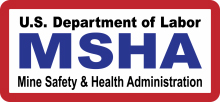MSHA proposes rule on workplace examinations
 Effective working place examinations are a fundamental accident prevention tool that allows mine operators to find and fix adverse conditions and violations of safety and health standards before they cause injury or death to miners. The Mine Safety & Health Administration (MSHA) announced today the publication of a proposed rule to enhance the quality of workplace examinations in metal and nonmetal mines around the United States.
Effective working place examinations are a fundamental accident prevention tool that allows mine operators to find and fix adverse conditions and violations of safety and health standards before they cause injury or death to miners. The Mine Safety & Health Administration (MSHA) announced today the publication of a proposed rule to enhance the quality of workplace examinations in metal and nonmetal mines around the United States.
From January 2010 through mid-December 2015, 122 miners died at metal and nonmetal mines. More than 60 percent of those deaths were linked to the “Rules to Live By” standards, violations of which are known to most frequently cause mining deaths. Sixty miners have died just since October 2013.
“We believe that many of these fatalities could have been prevented with better working place examinations,” says Joseph A. Main, assistant secretary of labor for mine safety and health. “MSHA has proactively provided notices to the mining industry on the need to improve mine site examinations, but now the time has come to require better, more effective examinations.”
Under the Federal Mine Safety and Health Act of 1977, mine operators have a responsibility to prevent the existence of conditions and practices that lead to injury, illness and death. “As evidenced by the fatalities at these mines, greater actions by mine operators are needed to find and fix hazards before miners get hurt or killed.” Main says. “Effective workplace examinations are critical to achieving that objective.”
The proposed rule would strengthen and improve MSHA’s standards for metal and nonmetal working place examinations by requiring that:
- A competent person examine the working place before miners begin work in that location.
- Mine operators promptly notify miners of any conditions that may adversely affect their safety or health.
- A competent person sign and date the examination record before the end of each shift. The examination record must include a description of locations examined, conditions found and corrective actions taken.
- Records must be made available for inspection by MSHA and miners’ representatives, and operators must provide a copy of the records upon request.
“The mining environment changes continuously, and that environment must be constantly monitored,” Main says. “Maintaining a record of adverse conditions found and corrective actions taken would help mine operators, miners and their representatives become more aware of dangerous and unhealthy conditions. These common-sense measures would also encourage operators to be more proactive in correcting these hazards before an accident, injury or fatality occurs.”
Under MSHA’s existing standards, a working place examination can be conducted at any time during the shift. The existing standards also do not address the contents of the examination record, do not require mine operators to promptly notify miners when adverse conditions are found and do not require operators to make the examination records available to miners’ representatives.
MSHA will hold four public hearings on its proposed rule on July 19 in Salt Lake City; July 21 in Pittsburgh; July 26 in Arlington, Va.; and Aug. 4 in Birmingham, Ala.









